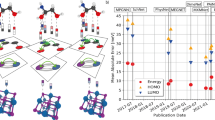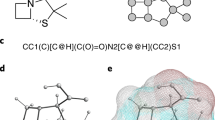Abstract
The reliable prediction of chemical reactivity remains in the realm of knowledgeable synthetic chemists. Automating this process by using artificial intelligence could accelerate synthesis design in future digital laboratories. While several machine learning approaches have demonstrated promising results, most current models deviate from how human chemists analyse and predict reactions based on electronic changes. Here, we propose a chemistry-motivated graph neural network called LocalTransform, which learns organic reactivity based on generalized reaction templates to describe the net changes in electron configuration between the reactants and products. The proposed concept dramatically reduces the number of reaction rules and exhibits state-of-the-art product prediction accuracy. In addition to the built-in interpretability of the generalized reaction templates, the high score–accuracy correlation of the model allows users to assess the uncertainty of the machine predictions.
This is a preview of subscription content, access via your institution
Access options
Access Nature and 54 other Nature Portfolio journals
Get Nature+, our best-value online-access subscription
$29.99 / 30 days
cancel any time
Subscribe to this journal
Receive 12 digital issues and online access to articles
$119.00 per year
only $9.92 per issue
Buy this article
- Purchase on Springer Link
- Instant access to full article PDF
Prices may be subject to local taxes which are calculated during checkout





Similar content being viewed by others
Data availability
The USPTO-480k dataset used in this manuscript is publicly available at https://github.com/wengong-jin/nips17-rexgen13. The source data used for each figure can be found at https://github.com/kaist-amsg/LocalTransform/releases/tag/raw_data40.
Code availability
The code for LocalTransform described in this manuscript is publicly available at https://github.com/kaist-amsg/LocalTransform40.
Change history
15 November 2022
A Correction to this paper has been published: https://doi.org/10.1038/s42256-022-00586-1
References
Engkvist, O. et al. Computational prediction of chemical reactions: current status and outlook. Drug Discov. Today 23, 1203–1218 (2018).
de Almeida, A. F., Moreira, R. & Rodrigues, T. Synthetic organic chemistry driven by artificial intelligence. Nat. Rev. Chem. 3, 589–604 (2019).
Struble, T. J. et al. Current and future roles of artificial intelligence in medicinal chemistry synthesis. J. Med. Chem. 63, 8667–8682 (2020).
Jorner, K., Tomberg, A., Bauer, C., Sköld, C. & Norrby, P.-O. Organic reactivity from mechanism to machine learning. Nat. Rev. Chem. 5, 240–255 (2021).
Wei, J. N., Duvenaud, D. & Aspuru-Guzik, A. Neural networks for the prediction of organic chemistry reactions. ACS Cent. Sci. 2, 725–732 (2016).
Segler, M. H. S. & Waller, M. P. Neural-symbolic machine learning for retrosynthesis and reaction prediction. Chem. Eur. J. 23, 5966–5971 (2017).
Coley, C. W., Barzilay, R., Jaakkola, T. S., Green, W. H. & Jensen, K. F. Prediction of organic reaction outcomes using machine learning. ACS Cent. Sci. 3, 434–443 (2017).
Schwaller, P., Gaudin, T., Lányi, D., Bekas, C. & Laino, T. ‘Found in translation’: predicting outcomes of complex organic chemistry reactions using neural sequence-to-sequence models. Chem. Sci. 9, 6091–6098 (2018).
Schwaller, P. et al. Molecular Transformer: a model for uncertainty-calibrated chemical reaction prediction. ACS Cent. Sci. 5, 1572–1583 (2019).
Tetko, I. V., Karpov, P., Van Deursen, R. & Godin, G. State-of-the-art augmented NLP transformer models for direct and single-step retrosynthesis. Nat. Commun. 11, 5575 (2020).
Irwin, R., Dimitriadis, S., He, J. & Bjerrum, E. Chemformer: a pre-trained transformer for computational chemistry. Mach. Learn.: Sci. Technol. 3, 015022 (2022).
Kayala, M. & Baldi, P. A. in Advances in Neural Information Processing Systems vol. 24 (NeurIPS, 2011).
Jin, W., Coley, C., Barzilay, R. & Jaakkola, T. in Advances in Neural Information Processing Systems vol. 30 (NeurIPS, 2017).
Coley, C. W. et al. A graph-convolutional neural network model for the prediction of chemical reactivity. Chem. Sci. 10, 370–377 (2019).
Bradshaw, J., Kusner, M. J., Paige, B., Segler, M. H. S. & Hernández-Lobato, J. M. A generative model for electron paths. In Int. Conf. for Learning Representations. (ICLR, 2019).
Do, K., Tran, T. & Venkatesh, S. Graph Transformation Policy Network for Chemical Reaction Prediction. In Proceedings of the 25th ACM SIGKDD International Conference on Knowledge Discovery & Data Mining, 750–760 (ACM, 2019).
Sacha, M. et al. Molecule edit graph attention network: modeling chemical reactions as sequences of graph edits. J. Chem. Inf. Model. 61, 3273–3284 (2021).
Qian, W. W. et al. Integrating deep neural networks and symbolic inference for organic reactivity prediction. Preprint at https://doi.org/10.26434/chemrxiv.11659563.v1 (2020).
Bi, H. et al. Non-autoregressive electron redistribution modeling for reaction prediction. In Proceedings of the 38th International Conference on MachineLearning. (PMLR, 2021).
Lowe, D. M. Extraction of chemical structures and reactions from the literature. Thesis, University of Cambridge (2012).
Tu, Z. & Coley, C. W. Permutation Invariant Graph-to-Sequence Model for Template-Free Retrosynthesis and Reaction Prediction. J. Chem. Inf. Model. 62, 3503–3513 (2022).
Li, M. et al. DGL-LifeSci: an open-source toolkit for deep learning on graphs in life science. ACS Omega 6, 27233–27238 (2021).
Gilmer, J., Schoenholz, S. S., Riley, P. F., Vinyals, O. & Dahl, G. E. Neural message passing for quantum chemistry. In Proceedings of the 34th International Conference on MachineLearning (PMLR, 2017).
Indigo toolkit. https://lifescience.opensource.epam.com/indigo/ EPAM [accessed 23 Aug 2022].
Jaworski, W. et al. Automatic mapping of atoms across both simple and complex chemical reactions. Nat. Commun. 10, 1434 (2019).
Schwaller, P., Hoover, B., Reymond, J.-L., Strobelt, H. & Laino, T. Extraction of organic chemistry grammar from unsupervised learning of chemical reactions. Sci. Adv. 7, eabe4166 (2021).
Toniato, A., Schwaller, P., Cardinale, A., Geluykens, J. & Laino, T. Unassisted noise reduction of chemical reaction datasets. Nat. Mach. Intell. 3, 485–494 (2021).
Kearnes, S. M. et al. The Open Reaction Database. J. Am. Chem. Soc. 143, 18820–18826 (2021).
Coley, C. W., Green, W. H. & Jensen, K. F. RDChiral: an RDKit wrapper for handling stereochemistry in retrosynthetic template extraction and application. J. Chem. Inf. Model. 59, 2529–2537 (2019).
Pesciullesi, G., Schwaller, P., Laino, T. & Reymond, J.-L. Transfer learning enables the molecular transformer to predict regio- and stereoselective reactions on carbohydrates. Nat. Commun. 11, 4874 (2020).
Pattanaik, L. et al. Message passing networks for molecules with tetrahedral chirality. Preprint at https://arxiv.org/abs/2012.00094 (2020).
Kearnes, S., McCloskey, K., Berndl, M., Pande, V. & Riley, P. Molecular graph convolutions: moving beyond fingerprints. J. Comput. Aided Mol. Des. 30, 595–608 (2016).
Li, Y., Tarlow, D., Brockschmidt, M. & Zemel, R. Gated graph sequence neural networks. In Int. Conf. for Learning Representations (ICLR, 2016).
Vaswani, A. et al. in Advances in Neural Information Processing Systems, pp 6000–6010 (NeurIPS, 2017).
Shaw, P., Uszkoreit, J. & Vaswani, A. Self-attention with relative position representations. In Proceedings of the 2018 Conference of the North American Chapter of the Association for Computational Linguistics: Human Language Technologies (NAACL-HLT, 2018)
Jumper, J. et al. Highly accurate protein structure prediction with AlphaFold. Nature 596, 583–589 (2021).
RDKit: Open-source cheminformatics; http://www.rdkit.org [accessed 23 Aug 2022].
Paszke, A. et al. PyTorch: an imperative style, high-performance deep learning library. Adv. Neural Inform. Process. Syst. 32, 8026–8037 (2019).
Kingma, D. P. & Ba, J. Adam: a method for stochastic optimization. In 3rd Int. Conf. for Learning Representations (ICLR, 2017).
Chen, S. kaist-amsg/LocalTransform: v1.0.0. Zenodo https://doi.org/10.5281/zenodo.6536406 (2022).
Chen, S. & Jung, Y. Deep retrosynthetic reaction prediction using local reactivity and global attention. JACS Au 1, 1612–1620 (2021).
Yasuma, T. & Negoro, N. Condensed ring compound. US patent 7820837B2 (2010).
Jensen, A. et al. Compounds. US patent 20080039450 (2008).
Yamada, A. et al. N-coating heterocyclic compounds. US patent 20030176454 (2003).
Acknowledgements
This work was supported by the Technology Innovation Program (20015850) funded by the Ministry of Trade, Industry and Energy (MOTIE, Korea) and the National Research Foundation of Korea (2019M3D3A1A01069099, 2019M3D1A1079303, 2021R1A5A1030054).
Author information
Authors and Affiliations
Contributions
S.C. and Y.J. conceived the project. S.C. designed the methods and performed the computational experiments and analyses. S.C. and Y.J. discussed the results and wrote the manuscript. Y.J. supervised the project.
Corresponding author
Ethics declarations
Competing interests
The authors declare no competing interests.
Peer review
Peer review information
Nature Machine Intelligence thanks the anonymous reviewers for their contribution to the peer review of this work.
Additional information
Publisher’s note Springer Nature remains neutral with regard to jurisdictional claims in published maps and institutional affiliations.
Supplementary information
Supplementary Information
Supplementary Sections 1–8, containing Supplementary Figs. 1–9, Tables 1–4 and discussion.
Rights and permissions
Springer Nature or its licensor (e.g. a society or other partner) holds exclusive rights to this article under a publishing agreement with the author(s) or other rightsholder(s); author self-archiving of the accepted manuscript version of this article is solely governed by the terms of such publishing agreement and applicable law.
About this article
Cite this article
Chen, S., Jung, Y. A generalized-template-based graph neural network for accurate organic reactivity prediction. Nat Mach Intell 4, 772–780 (2022). https://doi.org/10.1038/s42256-022-00526-z
Received:
Accepted:
Published:
Issue Date:
DOI: https://doi.org/10.1038/s42256-022-00526-z
This article is cited by
-
Prediction of chemical reaction yields with large-scale multi-view pre-training
Journal of Cheminformatics (2024)
-
Bidirectional generation of structure and properties through a single molecular foundation model
Nature Communications (2024)
-
Computational drug development for membrane protein targets
Nature Biotechnology (2024)
-
Precise atom-to-atom mapping for organic reactions via human-in-the-loop machine learning
Nature Communications (2024)
-
RetroRanker: leveraging reaction changes to improve retrosynthesis prediction through re-ranking
Journal of Cheminformatics (2023)



